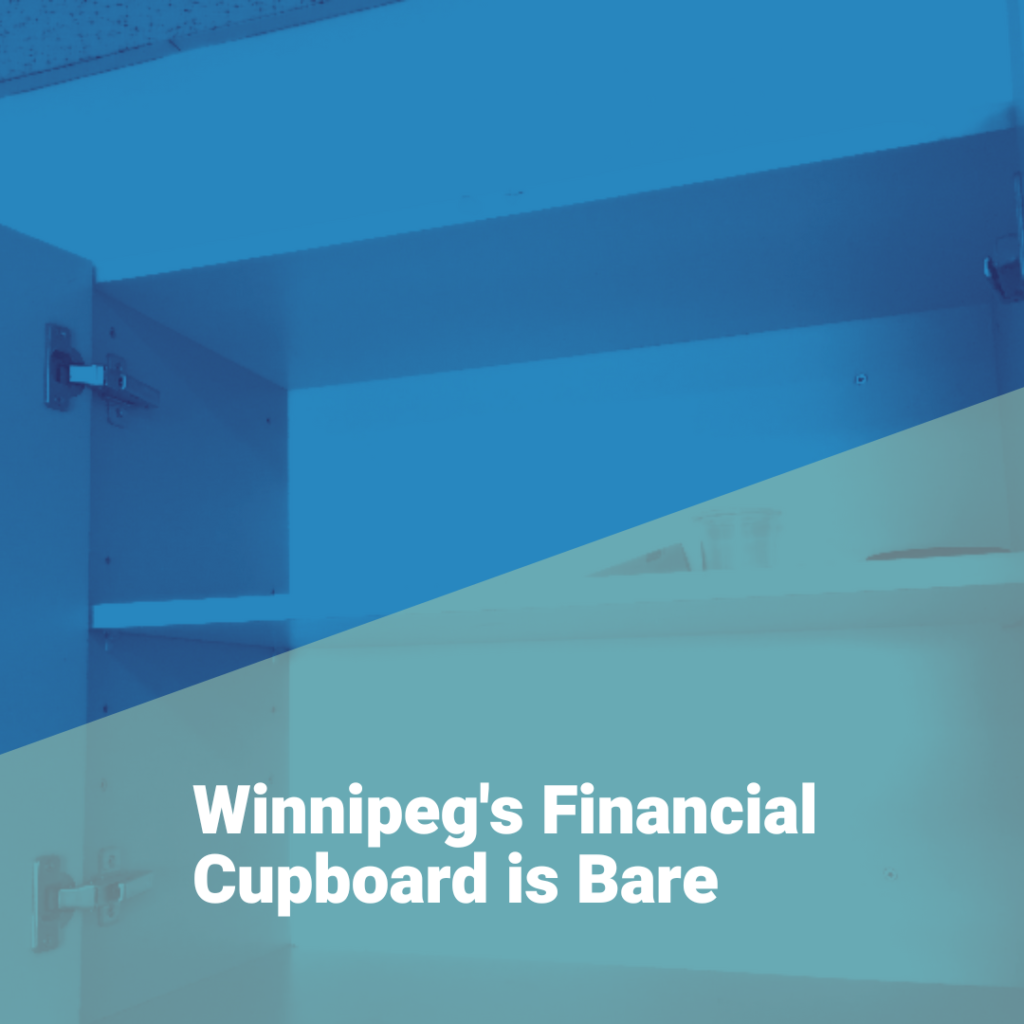
By Ian Hudson and Katherine Burley
The cupboard looks pretty bare at the City of Winnipeg. The City’s Financial Report, released earlier this month, predicted a $60 million dollar deficit in the operating budget and an additional $15 million shortfall for Transit. The City is attributing this to a perfect storm of hopefully temporary circumstances, like high gas prices, gigantic snowfalls, and the lingering impacts of COVID. However, the fact that snow can ruin the City’s finances shows how precarious they have become.
Strictly speaking, the City is not allowed to run a deficit. In practice, it draws from a fund called the Financial Stabilization Reserve, which is a rainy day fund set aside to top up revenue in times of budgetary difficulty. Transferring money from this fund to general revenue allows the budget to technically be balanced when it is really running a deficit. The Financial Report estimates that the rainy day fund, which stood at $120 million at the beginning of 2021, will fall to $20 million by the end of 2022. It shouldn’t take a certified accountant to realize that drawing $100 million out of a $120 million dollar fund over two years is unsustainable. It also places the City well below the minimum allowable size of the Fiscal Stabilization fund (6 percent of operating costs), of a little over $70 million in 2022.
This unsustainable situation has been decades in the making. Part of the problem is inherent in property taxes as a method of generating revenue. Unlike income or sales taxes, the tax base (the economic activity on which the tax is levied) for property taxes does not increase automatically as the economy grows. When the economy expands (or prices rise), revenue that governments collect through income and sales taxes increase even when the tax rate (the percentage of income or sales that is taxed) stays the same. This does not happen with property taxes.
The City’s current budget situation is a result of a 14-year refusal to increase property taxes prior to 2012. While the City has increased property taxes after 2012, between 1998 and 2020, Winnipeg increased its property taxes by much less than its Canadian counterparts.
Winnipeg now has the lowest annual taxes on an average home among major Canadian cities at $1850. The next lowest cities, like Saskatoon, Regina, Calgary, Vancouver all have municipal property taxes in the $2100-$2200 range. If Winnipeg raised the property tax on an average home by 7.33 percent (5 percent above the City’s budgeted increase of 2.33) it would increase by $136 per home and still remain the lowest in the country. This would raise about $34 million.
After comparing his property taxes between 1993 and 2022, my colleague at the University of Manitoba concluded recently (WFP, Sept 15, 2022): “Quite simply, property taxes must increase, and by a lot.”
To this not unreasonable conclusion, we might add a few caveats and ideas to diversify revenue.
First, come the caveats. The business tax has also fallen over the last two decades. After adjusting for inflation, the real value of the business tax has fallen by one third, from $60 million in 2001 to $40 million in 2022. Yet businesses continue to rely on city infrastructure and services in need of funding.
In this time of economic distress, low income homeowners should be also be protected. In 2018, Statistics Canada estimated that about 10,000 homeowners in “large urban centers” in Manitoba were in core housing need. Refunding the entire $136 increase mentioned earlier to these 10,000 homeowners would cost $1.36 million. This is a much better targeted intervention to help those in financial distress than holding down taxes for everyone.
Second, is the diversification of taxes. Winnipeg faces tax competition from municipalities that are within very easy commuting distance from the city, such as Headingley or East St. Paul. If people live in these communities and then commute into Winnipeg for work or leisure, they are, in fact, using Winnipeg infrastructure (most obviously roads) without paying for them. This free riding on city services allows outlying communities to charge lower taxes than is the case in Winnipeg. It also constrains the amount that Winnipeg can increase its property taxes because it has to worry about the incentive to construct new homes outside the perimeter.
There are several possible solutions to this issue, but one might be a commuter charge, in which people who reside outside the City are charged for each trip they make into town. This would have the triple benefit of alleviating the free riding problem, reducing the tax incentive to build outside the city limits, and discouraging single vehicle commuting.
In considering new forms of taxation, the general principle should be to increase the cost of things that are undesirable. An obvious example of this was the City’s impact fee that increased the cost of suburban developments that create expensive and unsustainable urban sprawl. While the specific fee in place by the City was struck down in court, the ruling was very clear that the general principle of a fee to recoup the cost of new suburban developments was permissible.
Another possibility is a surface parking lot fee on retail malls. This would equalize parking costs with downtown, create an incentive for greater urban density, which would facility more active transportation, and generate revenue to fund transit, reducing the number of cars on Winnipeg roads.
The bad news is that the City is in considerable financial trouble. The good news is that there are plenty of solutions available to an ambitious and creative new mayor and council.
Ian Hudson is a Professor of Economics at the University of Manitoba and a CCPA Mb research associate, Katherine Burley is an MA in Economics student at the University of Manitoba. For more please see “Winnipeg at a Crossroads: The 2022 Alternative Municipal Budget at https://policyalternatives.ca/publications/reports/winnipeg-crossroads


